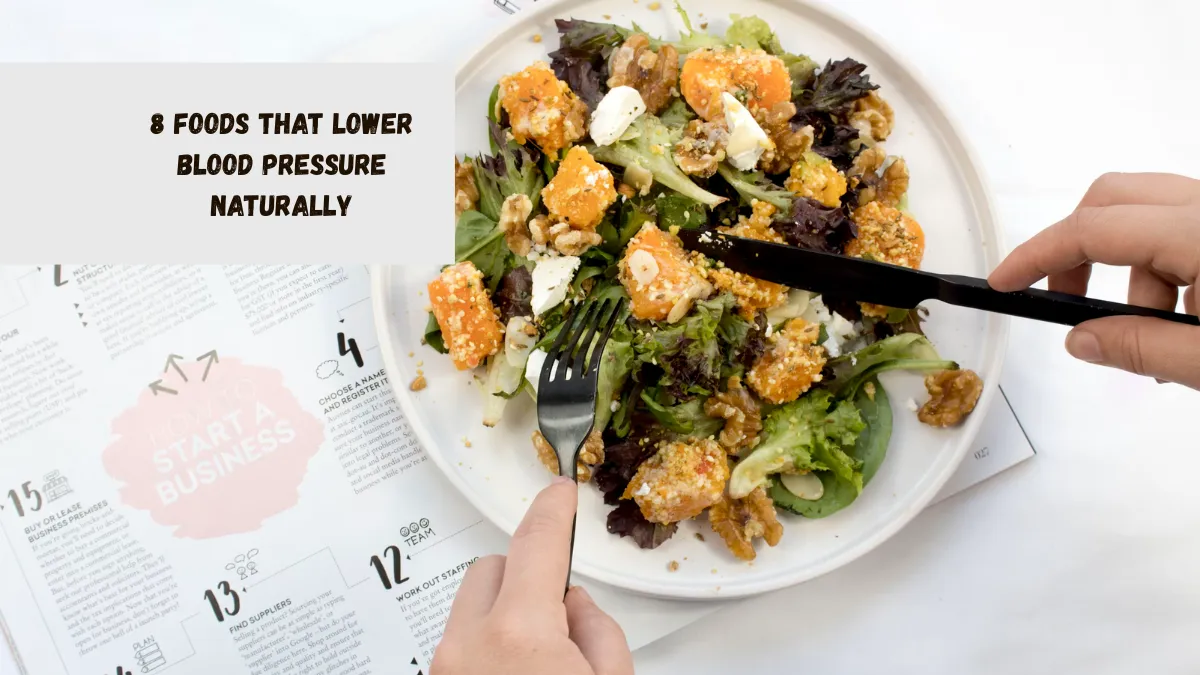A common medical issue affecting millions of people worldwide, high blood pressure raises the risk of heart disease and stroke. Although many doctors stress the need for natural food choices in properly controlling blood pressure, many prescriptions call for medication. By enhancing blood vessel performance, lowering inflammation, and balancing important minerals like potassium and magnesium, some foods included in your regular diet can help naturally decrease blood pressure.
Eight foods advised by experts that have been scientifically demonstrated to maintain normal blood pressure levels are investigated in this paper. From nutrient-dense leafy greens to antioxidant-rich berries and heart-healthy fatty fish, these foods provide great and easy approaches to taking charge of your cardiovascular health. Knowing how these items function and how to add them into your meals will enable you to make better nutritional choices and enhance your general state of health.
Leafy greens
Rich in potassium, a mineral absolutely vital for controlling blood pressure, leafy greens like spinach, kale, and collard greens Potassium helps the kidneys eliminate more salt through urine, hence lowering blood vessel pressure. To gain from their blood-pressure-lowering properties, experts advise including at least one serving of leafy greens daily. These veggies’ high nitrate content also encourages vasodilation, in which case blood vessels relax and enlarge to facilitate more seamless blood flow. Including greens in meals may be as easy as tossing salads or smoothies with spinach.
Cooking techniques also matter; boiling could cause nutritional loss, while gently steaming greens maintains their potassium levels. Furthermore, helping heart health and preserving a good weight is these veggies’ low calorie and high fiber content. Match greens with meals high in healthy fats, such as olive oil, which helps to absorb nutrients, to optimize benefits. Studies repeatedly point to a diet heavy in leafy greens helping to reduce systolic and diastolic blood pressure, therefore lowering the risk of cardiovascular illnesses. From soups to wraps, these adaptable veggies may be imaginatively added to many meals, therefore providing both a practical and nutritional value.
Berries
Powerhouses of antioxidants called flavonoids, berries—blueberries, strawberries, and raspberries—have been linked to lower blood pressure. Flavonoids promote endothelial function, therefore allowing blood vessels to relax and retain flexibility—qualities essential for ideal blood pressure levels. Furthermore, high in vitamin C, these fruits help circulation by supporting the integrity of blood vessel walls and so lowering stiffness. Regular berry consumption has been linked in studies to a decreased risk of hypertension.
One of the main causes of high blood pressure, oxidative stress, is reduced in berries by their polyphenols. Including berries in the diet might be as easy as eating them as a snack or mixing them into yogurt or cereal. Retaining most of their nutrients, frozen berries are equally healthy as fresh ones. Berries also have dietary fibers, which help control cholesterol and another element affecting blood pressure. To maximize the cardiovascular effects of mixed berries, experts advise at least one cup per day. Berries are a pleasing approach to controlling blood pressure without sacrificing taste or texture, as they are inherently sweet and low in calories.
Beets
Celebrated for their high nitrate content, beets are turned by the body into nitric oxide, a chemical that aids in relaxation and dilation of blood vessels. Because nitric oxide increases blood flow and lowers vascular resistance, this procedure greatly lowers blood pressure. Studies indicate that drinking beet juice can cause systolic BP to drop noticeably in a few hours. Rich in folate as well, beets assist cardiovascular health by preserving artery flexibility.
Including beets in the diet is easy and flexible; roasting, boiling, or mixing them into smoothies are all good ways. Though cooked beets are still good, raw beets and beet juice have the highest nitrate level. Apart from nitrates, beets include betalains, which have anti-inflammatory effects, therefore enhancing heart condition. Nutritionists advise at least a few times a week to help control blood pressure. Beets fit side dishes and salads, as their earthy taste complements citrus and herbs. Along with helping to reduce blood pressure, regular intake enhances general vascular health and endurance.
Oats
An outstanding source of soluble fiber, especially beta-glucan, which has been demonstrated to lower cholesterol and enhance vascular function, is oats. Lower cholesterol results in less plaque building in arteries, therefore improving blood flow and lowering blood pressure. Whole oats taken daily have been associated with a notable decrease in systolic and diastolic blood pressure. Magnesium is another component of oats; it functions as a natural vasodilator, therefore relaxing blood vessels. Oatmeal, overnight oats, or oat-based smoothies all let you include oats in morning rituals.
Choosing whole, unprocessed oats instead of quick kinds guarantees more fiber and nutritional preservation. Furthermore, low glycemic index oats help to minimize blood sugar surges that could indirectly influence blood pressure. Combining oats with fresh fruit—such as berries—increases their antioxidant value, therefore providing a double advantage. Consuming oats regularly not only improves heart health but also helps to keep steady energy levels all day, therefore lowering the risk of exhaustion connected to hypertension. Choosing oats as a morning staple can help with long-termular well-being, experts stress.
Fatty Fish
High in omega-3 fatty acids, fatty fish, including salmon, mackerel, and sardines, have been shown to decrease blood pressure and ease inflammation. Omega-3s improve endothelial performance and lower arterial stiffness, thereby fostering better blood flow. Consuming fatty fish regularly has been linked to lower triglyceride levels, which also help heart health. To preserve the best cardiovascular performance, the American Heart Association advises at least two meals of fatty fish a week.
Additionally high in vitamin D, fatty fish improve calcium balance and vascular tone, so helping to control blood pressure. While avoiding bad fats, baking, grilling, or boiling fish keeps its nutritious value. Including these fish with veggies will produce a balanced, heart-healthy dinner. Convenient and with most of its omega-3 content retained, canned versions of salmon or sardines Apart from helping to control blood pressure, the anti-inflammatory qualities of fatty fish lower the incidence of heart attacks and strokes. Regular inclusion of them will help to significantly preserve blood pressure within a normal level.
Garlic
Through its vasodilatory properties, garlic’s allicin—a sulfur compound—has been connected to decreasing blood pressure. By relaxing smooth muscle cells in blood vessel walls, allicin increases blood flow. Studies show, especially in those with hypertension, garlic supplements can cause notable drops in systolic and diastolic blood pressure. Raw garlic is the best, as cooking might lower its allicin level. Whether raw, roasted, or as a condiment, including garlic in everyday meals can consistently help your heart.
Apart from blood pressure, garlic helps control cholesterol and lowers oxidative stress, elements influencing vascular condition indirectly. Its immune-boosting qualities make it a good complement to many diets, particularly for people who run the danger of cardiovascular problems. Garlic’s advantages can be doubled by combining it with heart-healthy lipids such as olive oil. Apart from enhancing vascular performance, regular garlic intake helps to lower the risk of heart diseases. Practical and useful as a flexible ingredient, it may be included in marinades, sauces, and dressings.
Yogurt
Rich in calcium and bacteria, yogurt helps to preserve normal blood pressure levels via means of both While probiotics enhance gut health and may thus indirectly affect blood pressure control, calcium helps control vascular contraction and dilation. Studies have indicated that persons who consume low-fat dairy, including yogurt, often have lower blood pressure than those who eat less dairy. Yogurt also includes potassium, which helps the body balance salt levels and hence supports cardiovascular health.
Choosing low-fat, unsweetened yogurt improves its advantages, as extra sugars could offset its favorable effects. Yogurt guarantees regular consumption whether used as a snack, morning food, or component in smoothies. Greek yogurt, among other fermented foods, might have more probiotic value. Yogurt combined with berries or other fruits makes a nutrient-dense, heart-healthy lunch. Yogurt’s regular intake helps not just good blood pressure but also digestion and a balanced microbiota, therefore enhancingeral well-being.
Dark Chocolate
Thanks to its strong concentration of antioxidants, dark chocolate with at least 70% cocoa content is well known for naturally helping to decrease blood pressure. Strong antioxidants, these plant-based substances boost nitric oxide generation in the body, therefore relaxing blood arteries and increasing blood flow. Lower blood pressure results from the reduction in resistance the vasodilation effect causes against which the heart pumps.
Particularly in those with hypertension, research shows that modest consumption of dark chocolate—about one to two tiny squares daily—can clearly lower systolic and diastolic blood pressure. Dark chocolate types low in added sugars and harmful fats should be chosen, as they can offset some of the cardiovascular advantages. Dark chocolate also has minerals like potassium and magnesium that help cardiac function. Including dark chocolate as a sporadic treat may be a tasty and efficient approach to help with natural blood pressure control and appropriately satisfy sweet needs.
Bottom Line
Including these eight items in your diet can naturally help to maintain normal blood pressure and support heart health. You use nature to lower blood pressure without depending just on medicine by concentrating on nutrient-dense, whole foods such as leafy greens, berries, beets, oats, fatty salmon, garlic, yogurt, and dark chocolate. Combining these meals with a healthy lifestyle can help to sustain cardiovascular benefits and enhance quality of life.
FAQs
Can eating these foods replace blood pressure medication?
While these foods can help manage blood pressure naturally, they should complement, not replace, any prescribed medication. Always consult your doctor before making changes.
How quickly can I see results from eating these foods?
Some people may notice improvements within weeks, but long-term consistency is key for sustained blood pressure control.
Are these foods safe for everyone?
Generally, yes, but individuals with specific conditions or allergies should consult a healthcare professional before making dietary changes.
How much of these foods should I eat daily?
Moderation is important; aim for regular servings based on expert guidelines, such as one cup of leafy greens or two servings of fatty fish per week.




